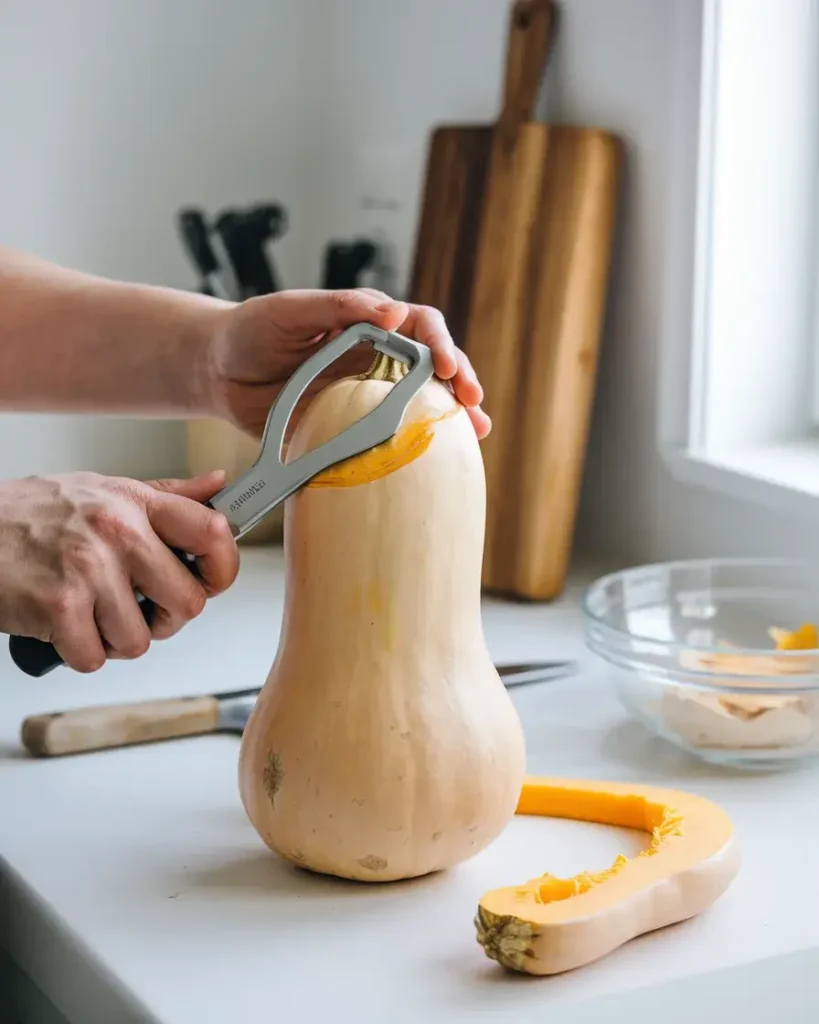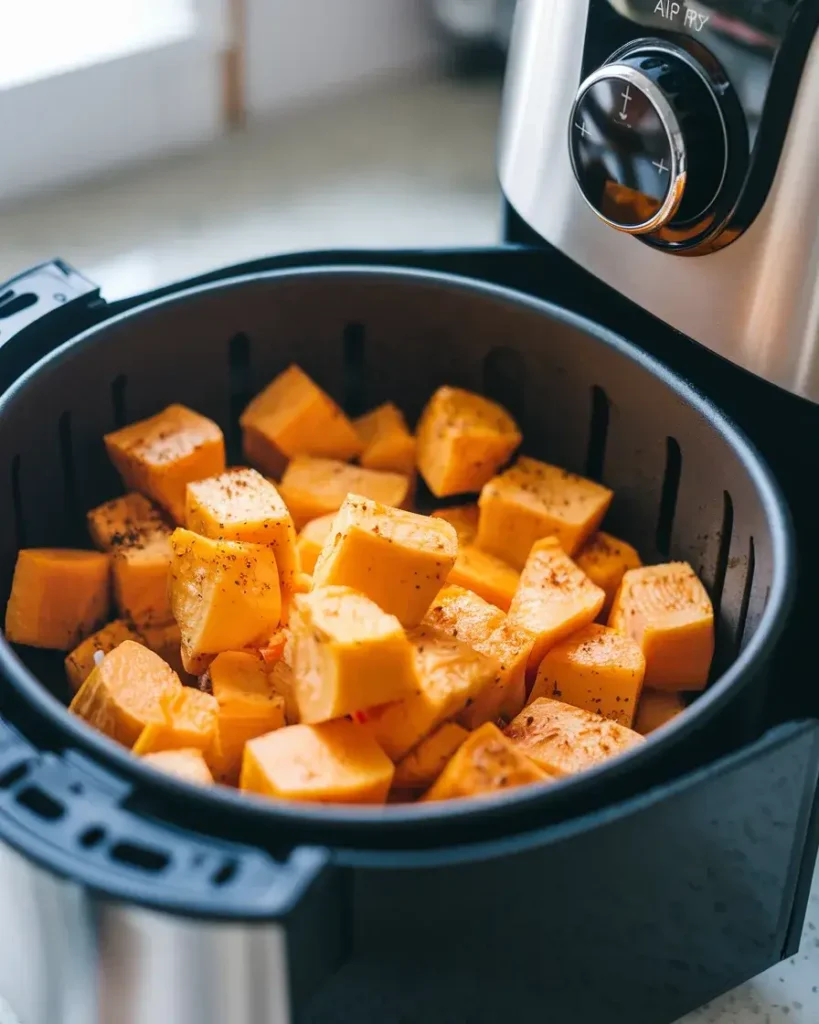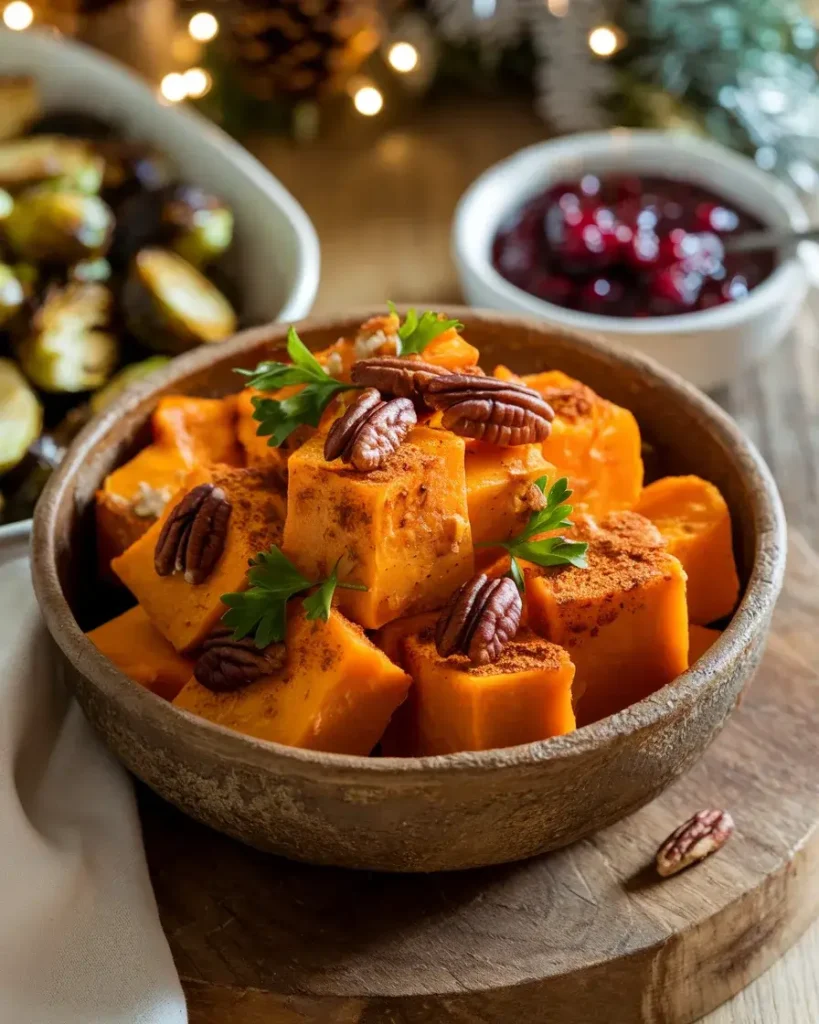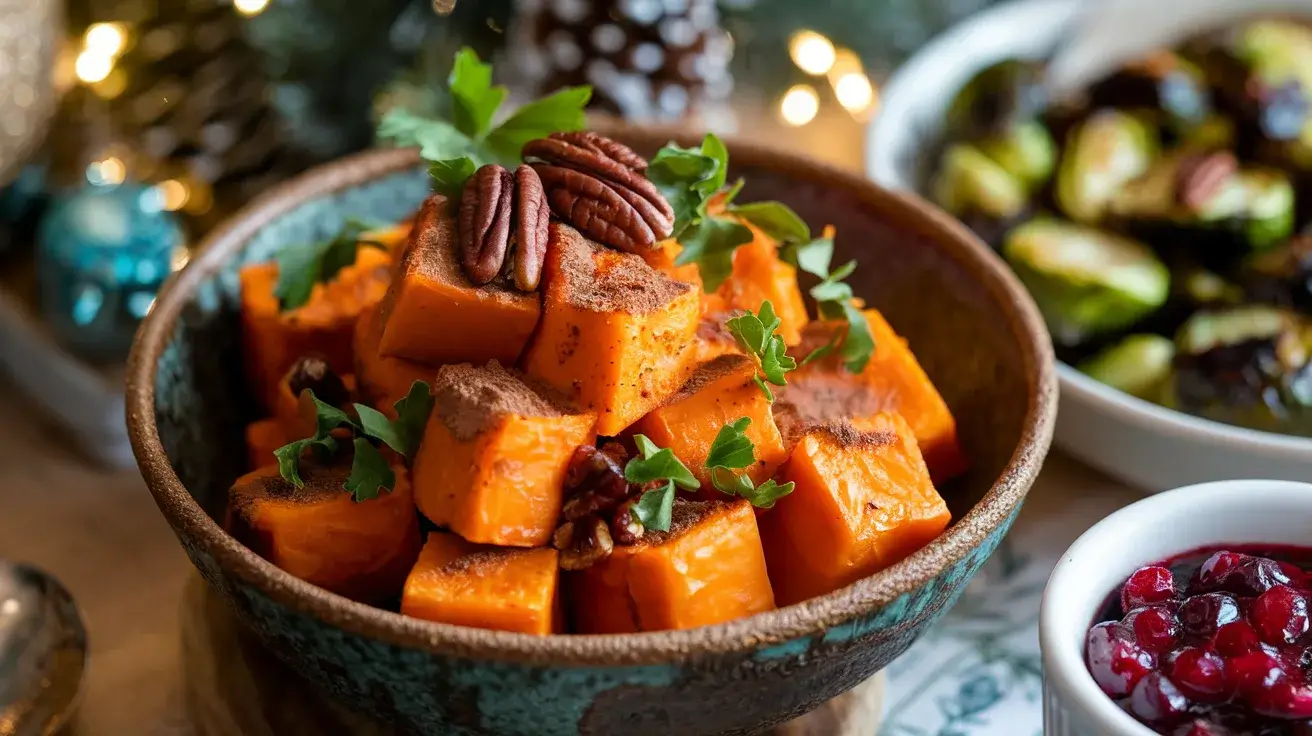Introduction
When it comes to preparing a dish that’s both simple and bursting with flavor, air fryer butternut squash is a winning choice. This guide walks you through every step of making this seasonal favorite—from choosing the perfect squash to serving it up at your next holiday feast. Whether you’re a seasoned cook or a kitchen newbie, you’ll find everything you need to create tender, caramelized butternut squash with minimal effort. Plus, cooking it in an air fryer saves time and frees up your oven for other dishes. Let’s dive in!
Table of Contents
Why Choose Air Fryer Butternut Squash?
What Makes Air Fryer Butternut Squash Unique?
Cooking butternut squash in an air fryer offers a combination of ease and flavor that’s hard to beat. With its compact design, an air fryer caramelizes the squash beautifully, giving it slightly crispy edges and a tender, sweet interior. Plus, this method is faster than traditional oven roasting and doesn’t require constant monitoring.
The natural sweetness of butternut squash comes alive when combined with the right seasonings. By air frying, you get consistent results every time, with the squash perfectly cooked through.
Nutritional Value and Seasonal Appeal
Not only is butternut squash a fall favorite, but it’s also a nutritional powerhouse. Packed with vitamins A and C, fiber, and antioxidants, it’s a healthy side dish that complements hearty meals like roasted turkey, glazed ham, or even a simple grain bowl.
Fall and winter are peak seasons for butternut squash, making it a fresh and budget-friendly ingredient during this time. Plus, its warm, earthy flavors pair perfectly with the comforting spices of the season, like sage, garlic, and paprika.
Selecting and Preparing Butternut Squash for Air Frying

How to Choose the Best Butternut Squash
When it comes to making air fryer butternut squash, starting with a quality squash is key. Always pick one that feels heavy for its size. A ripe squash has a hard, evenly colored beige skin, free from soft spots or deep blemishes. If it has a green tint, it might not be fully mature yet.
For air frying, medium-sized squashes (about 2 to 3 pounds) work best. They’re easier to handle and usually fit better in most air fryer baskets. If you’re cooking for a crowd, you might need more than one, but it’s always a good idea to test your air fryer capacity first.
Step-by-Step Guide to Cutting and Peeling
Preparing butternut squash might seem intimidating at first, but with the right tools and steps, it’s a breeze. Begin by cutting off the top and bottom ends of the squash to create a stable surface. Use a vegetable peeler to remove the tough outer skin—this step is crucial for cubes but unnecessary for roasting halves.
Next, cut the squash in half where the neck meets the round base. Scoop out the seeds from the base using a spoon. For cubes, slice each section into rounds and then into bite-sized pieces. Keeping the cubes uniform ensures they cook evenly in the air fryer.
Pre-Cut vs. Whole Squash: Pros and Cons
If you’re short on time, pre-cut butternut squash cubes are a lifesaver. They’re convenient and ready to cook, but they can sometimes be less fresh than cutting a whole squash yourself. On the other hand, whole squash is more budget-friendly and stays fresh longer, but it requires extra prep time. Whichever option you choose, air frying works equally well for both.
Essential Ingredients and Substitutions
Core Ingredients for Flavorful Squash
To make mouthwatering air fryer butternut squash, you’ll need just a handful of simple ingredients. Olive oil (or avocado oil) helps the seasonings stick and aids in caramelization. Maple syrup adds a touch of sweetness, enhancing the squash’s natural flavor.
For seasoning, dried Italian herbs bring out the earthy flavors of the squash. Garlic powder, smoked paprika, and a pinch of sea salt round out the savory and smoky notes. Want a bit more warmth? Add a sprinkle of cinnamon or nutmeg to give it a festive twist.
Substitute Options for Dietary Preferences
Cooking for someone with dietary restrictions? No problem! You can swap olive oil for a neutral-flavored oil like grapeseed, or use brown sugar instead of maple syrup for a slightly different sweetness. For a vegan version, double-check that your syrup is plant-based.
Spices can be adjusted, too. If smoked paprika isn’t your thing, regular paprika works just fine. And for those who like it spicy, a dash of cayenne pepper or chili flakes adds a bit of heat. With these easy swaps, your air fryer butternut squash will suit any palate.
Cooking Methods: Air Fryer Squash Cubes vs. Halves

Preparing and Cooking Squash Cubes
Making air fryer butternut squash cubes is one of the easiest and quickest ways to enjoy this dish. Once the squash is peeled and diced into 1-inch cubes, toss them in a mixture of olive oil, maple syrup, garlic powder, and dried herbs. The maple syrup not only adds sweetness but also helps create those golden caramelized edges.
Arrange the cubes in a single layer in your air fryer basket. Crowding the basket can lead to uneven cooking, so if you’re working with a large amount, cook in batches. Set the air fryer to 400°F and cook for about 13–15 minutes, shaking the basket halfway through for even browning. Once the squash is fork-tender and slightly crispy, it’s ready to serve.
Roasting Butternut Squash Halves
For those who prefer less prep work, air frying squash halves is a fantastic alternative. Start by cutting the squash lengthwise and scooping out the seeds. Brush the flesh with a bit of oil and sprinkle it with seasonings like smoked paprika and salt.
Place the halves flesh-side up in the air fryer. Cook at 360°F for about 15 minutes, then brush with a touch of maple syrup and continue cooking for another 10–15 minutes. The result? Buttery, tender squash with a slightly crispy surface, perfect for scooping and serving alongside hearty mains.
For more air fryer recipes, check out Flavor Festivity’s Air Fryer Recipe Ideas.
Serving Suggestions and Pairings

Holiday Side Dish Ideas
Air fryer butternut squash is a delightful addition to any holiday spread. Pair it with classics like roasted turkey, ham, or stuffing for a balanced meal. To add crunch, sprinkle the squash with roasted nuts like pecans or pumpkin seeds just before serving.
If you’re hosting a fall dinner party, consider serving the squash as part of a seasonal grain bowl. Combine it with quinoa, roasted Brussels sprouts, dried cranberries, and a drizzle of balsamic glaze for a dish that’s as vibrant as it is delicious.
Creative Uses for Leftovers
Got extra butternut squash on hand? Leftovers can be transformed into entirely new dishes. Toss the cubes into a salad with mixed greens, goat cheese, and a citrus vinaigrette. Or, blend them into a creamy soup for a comforting lunch.
You could even add the squash to a warm pasta dish for a cozy dinner. The slightly sweet flavor pairs wonderfully with savory sauces like sage brown butter or garlic cream.
For more creative kitchen inspiration, check out Flavor Festivity’s Leftover Recipes.
Storage and Reheating Tips
Best Practices for Refrigeration and Freezing
If you’ve made a batch of air fryer butternut squash and have leftovers, proper storage is key to keeping them tasty. Let the squash cool completely before transferring it to an airtight container. Refrigerated, it stays fresh for up to 4 days.
If you’re planning to freeze it, make sure the cubes are stored in a freezer-safe bag or container. It’s helpful to lay them flat in a single layer to prevent clumping. Frozen butternut squash is best used within 1–2 months for the best flavor and texture.
Reheating Techniques for Perfect Results
Reheating air fryer butternut squash is simple and quick. For the best results, toss the cubes back into the air fryer at 400°F for 3–5 minutes. This method restores the crispy edges while warming them through.
Alternatively, you can use a microwave for convenience, though the texture may become slightly softer. For halves, scooping the flesh into a microwave-safe dish before reheating ensures even warming.
Troubleshooting and Common Mistakes
Why Your Squash May Not Be Tender
Sometimes, air fryer butternut squash can come out less tender than expected. This issue often happens when the cubes or halves are cut too large, making them harder to cook evenly. Cutting the squash into smaller, uniform pieces can solve this problem.
Another common reason is insufficient cooking time. Air fryers can vary in power, so adding an extra minute or two can make a big difference. Always test the squash with a fork to check for doneness.
Avoiding Burnt or Overcooked Squash
Burnt squash is often a result of overcrowding the air fryer basket. When pieces overlap, they don’t cook evenly, leading to burnt edges and undercooked centers. Cooking in batches prevents this and ensures consistent results.
Using too much seasoning, especially sugary ingredients like maple syrup, can also lead to burning. A light coat is all you need for flavor without risking charred pieces. Lastly, keep an eye on the timer and shake the basket halfway through cooking to avoid overcooking.
FAQs About Air Fryer Butternut Squash
Can Frozen Butternut Squash Be Used in the Air Fryer?
While fresh squash is ideal for making air fryer butternut squash, frozen squash can work in a pinch. However, frozen cubes tend to release more water during cooking, which can make them slightly mushy instead of crisp. To improve the texture, pat the frozen squash dry with a paper towel before seasoning and cooking. Keep in mind, the cooking time may be shorter, so check on them frequently.
Do I Need to Peel Butternut Squash Before Cooking?
If you’re preparing squash cubes for your air fryer, peeling is a must. The skin of butternut squash is tough and doesn’t soften much during cooking, which can make it unpleasant to eat. However, if you’re air frying squash halves, the skin can stay on—it acts as a natural barrier to lock in moisture. Once cooked, the flesh scoops out easily, leaving the skin behind.
What Other Types of Squash Can Be Air Fried?
Butternut squash isn’t your only option when it comes to air frying. Other varieties like acorn squash, kabocha, or delicata squash work beautifully too. Each type brings its own unique flavor and texture, but the cooking method remains the same. Just adjust the time slightly based on the size and density of the squash you choose.
Conclusion and Final Tips
Recap of Benefits and Key Techniques
Making air fryer butternut squash is a quick and satisfying way to enjoy this versatile veggie. With its crispy edges and tender center, it’s perfect for everything from weeknight meals to holiday feasts. By following these tips—like cutting the squash evenly, seasoning lightly, and avoiding overcrowding your basket—you’ll get flawless results every time.
Encouragement to Experiment with Flavors
Don’t be afraid to make this recipe your own. Whether you add a dash of spice for heat or a sprinkle of cinnamon for sweetness, there are endless ways to customize air fryer butternut squash. Pair it with your favorite main dishes or serve it as a stand-alone star.
For even more kitchen inspiration, consider checking out similar recipes on Flavor Festivity to expand your repertoire of creative, flavorful dishes.

